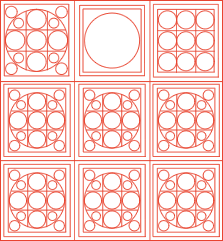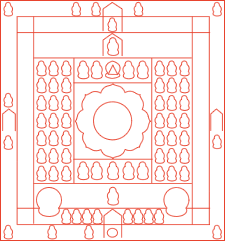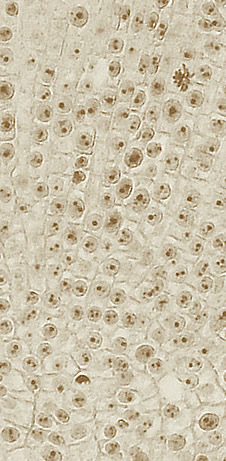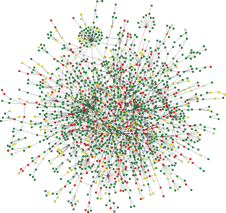| Art: Index > Mandala - Viewing as a whole |
| Mandala - Viewing as a whole |
| When it views from a microcosmic scale, contemporary biology too must make a connection somewhere with the important question, what is life. They will share this with the view of life in antiquity. |
 |
 |
The Ryokai Mandala (Den Shingonin Mandala), Heian Period / In the collection of Toji Temple
|
|
 |
Kongokai Mandala (Diamond Mandala) ■ Knowledge (The intellectual element in the awareness of truth) / Effect ■ Great strength (Lightning, diamonds) = Absolute light and hardness ■ Spirituality, space, diversity / The top side of Mandala faces toward the west. |
 |
Taizokai Mandala (Womb Mandala) ■ Truth (Showing the essential element) / Cause ■ Lotus = The symbol of equality in a similar form ■ Materiality, time, commonality / The top side of the Mandala faces toward the east. |
One of these legacies is the mandala. It reveals the view of the universe in Mikkyo Buddhism, and shows the world of Buddhism in visible form. Mandalas use such stable forms as squares and circles. They have been created with extreme precision using bold lines. They permit us to visually experience sacred space, and have been objects of veneration in Mikkyo temples. In addition, they have been appreciated as exceptional works of art and have attracted the attention of different scholars, including the psychologist Jung. The word mandala in the Sanskrit language of India means “that which has an essence”. A mandala establishes an objective focal point in the Buddha, and has been arranged in a concentrated form. Because of its marvelous apprehension of essence, it has the potential to admit different viewpoints and interpretations. There are several different types of mandalas, but let us examine the Ryokai mandala that came to us by way of China. The two parts make up the whole, and both depict as their principal image the Dainichi Nyorai, or the great Buddha, in the center. The mandalas spread out from the center to the periphery like a flower blooming, and there is a whirlpool-like flow on the square board. They also can be viewed as having a reverse flow into the center. Believers can travel through the mandala to answer the question of which Buddha will be their salvation, and ascetic monks can do the same to answer their question about the process from moving from the edges of the mundane world to reach Nirvana. They both will come to know the Buddha they seek and their own position. Mandalas are like a map, and they are also like a door linking the profane and the sacred. Understanding the respective meanings of these two mandalas (refer to the front page) can be thought of as just like having a conversation on a living creature. Their complementarity is reminiscent of double helical DNA. Their diversity and commonality, and their time and space, are characteristics of the genome. Kumagusu Minakata interpreted and developed mandalas while freely incorporating his own ideas. Minakata considered nature, the human spirit, science, and daily life as a whole. The Minakata Mandala, which he drew, represents his conception of the world in a diagram. It is interesting that in recent years, we have learned it resembles a dependency diagram of the substances in a cell. In the midst of a complex relationship with the natural world, human beings try to arrange its order and chaos and understand. The Biohistory Journal uses the genome as the entry point to conceive of and depict our location as humans and as individuals from the perspective of evolution, generation, and the ecological system. It has created a modern mandala, and it is the wisdom for considering the act of living from that. Naoko Kitaji |
|
"Lethality and centrality in protein networks" H.Jeong et al.
|
|
|
Are they similar or different? Photosynthesis and the aerobic respiration | ||
|
|
Astrocytes, supporting adaptable brain function | ||
| Rsearch |
|
Please close a window with the button of a browser who are turning off Javascript. |

